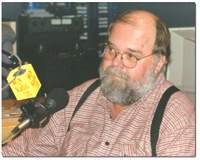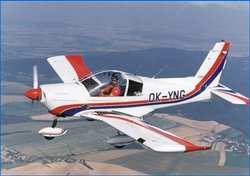7th Circuit Court Keeps FAA From Taking Legal Blame
 The FAA can not be
held responsible for the February 8, 2000 midair that took the life
of radio personality Bob Collins (pictured right), and two others.
The 7th Circuit US Court of Appeals upheld a ruling, Friday,
denying the suit filed by Collins' family due to the legal
protections inherent in Federal Immunity. While the FAA may, in
fact, have been responsible, the court action pretty much says that
the family can't penalize the FAA for the damages that they have
encountered.
The FAA can not be
held responsible for the February 8, 2000 midair that took the life
of radio personality Bob Collins (pictured right), and two others.
The 7th Circuit US Court of Appeals upheld a ruling, Friday,
denying the suit filed by Collins' family due to the legal
protections inherent in Federal Immunity. While the FAA may, in
fact, have been responsible, the court action pretty much says that
the family can't penalize the FAA for the damages that they have
encountered.
Collins was flying a Moravan Z242L (file photo,
below) with two others on board and was involved in a
collision with a Cessna 172 over Zion, IL, with one aboard. All
involved in the accident were killed.
The NTSB report said that on February 8th, 200, at 1455:29, the
pilot of N5ZA (flown by Collins), a Moravan Z242L, called the
Waukegan Regional Airport (UGN) air traffic control tower (ATCT)
and reported 15 miles northeast for landing. The local controller
(LC) acknowledged and queried N5ZA, "are you coming down the
shoreline?" N5ZA responded, "That's affirmative." (Radar data
showed that N5ZA was actually 4.5 miles east of the shoreline). The
LC instructed the pilot to "report turning final at the shoreline
for the straight in [to] runway two three." The pilot responded,
"ok, straight in for two three, thanks." At 1457:57, the LC
instructed N99063, a Cessna 172P, to taxi into position and hold,"
and, 10 seconds later, he cleared N99063 for takeoff. At 1459:48,
the LC asked the pilot of N5ZA for his position. The pilot replied
that he was "just about a mile or two off the lake...off the
shoreline." (However, radar data showed that N5ZA was actually 3.75
miles off the shore along the runway 23 extended centerline and 2.7
miles from shore with the shoreline being abeam to the right side
of the aircraft.) At 1459:53, the LC asked the pilot, "are you
straight in still?" The pilot responded, "ah, yes sir." The LC
instructed the pilot to "keep your speed up as much as feasible
cleared to land." The pilot acknowledged and stated, "peddling as
fast as I can." At 1500:38, the LC instructed N99063 to "continue
on the downwind, advise when you see a red low wing aircraft
straight in on final."
The pilot of N99063 responded, "looking for traffic." (Radar
data showed that N99063 was established on the downwind leg,
approximately 0.7 miles due north of the approach end of runway 23.
The radar also showed that N5ZA was 2.3 miles northeast of the
shoreline, 6.3 miles from the approach end of runway 23.) At
1500:50, the pilot stated, "zulu alpha's the white zlin." The LC
acknowledged and transmitted to N99063, "it'll be a white low wing
aircraft." The pilot of N99063 acknowledged. At 1501:16, the pilot
of N99063 stated, "negative traffic," and asked the LC to advise
her when to turn for her base leg. The LC acknowledged. (Radar data
showed that N99063 was 1.75 miles northeast of the approach end of
runway 23 and that N5ZA was 1.4 miles northeast of the shoreline,
5.3 miles from the approach end of runway 23.) At 1501:41, the LC
asked the pilot of N5ZA how far out he was from the shoreline; the
pilot responded that he was "just crossing the shoreline." (Radar
data showed that N5ZA was 0.8 miles from the shoreline,
approximately 4.8 miles from the approach end of runway 23.) At
1502:09, the LC asked the pilot of N99063 if she saw N5ZA yet.
 The pilot of N99063
responded, "negative." The LC asked the pilot of N99063, "have you
passed the shoreline?" The pilot of N99063 replied, "gettin there."
(Radar data showed that N99063 was 1.6 miles from the shore along
the extended downwind leg for runway 23's right-hand traffic
pattern.) At 1502:16, the LC instructed N99063 to "start your base
leg now." The pilot of N99063 acknowledged. (Radar data showed N5ZA
crossing the shoreline, 4 miles from the approach end of the runway
23. As the pilot of N99063 turned onto base leg, then final
approach, the airplane was slightly in front of N5ZA.) At 1503:19,
the pilot of N5ZA reported, "negative contact with the cessna in
front of us." (Radar data showed that N5ZA was approximately 2.6
miles from the approach end of runway 23.) The LC replied, "you
should be number one, Bob." At 1503:27, the pilot of N5ZA stated,
"then we have the traffic in sight, thanks." (Radar data showed
that N99063 established on final 2.5 miles from the approach end of
runway 23.) At 1503:38, the LC instructed the pilot of N99063 to
"advise when you turn final."
The pilot of N99063
responded, "negative." The LC asked the pilot of N99063, "have you
passed the shoreline?" The pilot of N99063 replied, "gettin there."
(Radar data showed that N99063 was 1.6 miles from the shore along
the extended downwind leg for runway 23's right-hand traffic
pattern.) At 1502:16, the LC instructed N99063 to "start your base
leg now." The pilot of N99063 acknowledged. (Radar data showed N5ZA
crossing the shoreline, 4 miles from the approach end of the runway
23. As the pilot of N99063 turned onto base leg, then final
approach, the airplane was slightly in front of N5ZA.) At 1503:19,
the pilot of N5ZA reported, "negative contact with the cessna in
front of us." (Radar data showed that N5ZA was approximately 2.6
miles from the approach end of runway 23.) The LC replied, "you
should be number one, Bob." At 1503:27, the pilot of N5ZA stated,
"then we have the traffic in sight, thanks." (Radar data showed
that N99063 established on final 2.5 miles from the approach end of
runway 23.) At 1503:38, the LC instructed the pilot of N99063 to
"advise when you turn final."
The pilot of N99063 reported that she was on final approach. The
LC said, "thank you." At 1503:53, the LC asked N5ZA, "do you see a
cessna in front of you?" At 1504:00, the pilot of N5ZA responded,
"[N5ZA] just had a midair." The LC responded, "we just saw that."
(The last radar target from N5ZA was received at 1503:59 and showed
that N5ZA was 2 miles from the approach end of runway 23.)
Both airplanes came down in the city of Zion, Illinois. N5ZA
impacted into the roof of a hospital, and subsequently exploded.
N99063 struck a tree and a sidewalk before coming to rest on a
residential street. Examinations of the wreckage of both airplanes
revealed no anomalies.
The NTSB's Probable Cause report concluded that, "The pilot's
failure to maintain clearance from the other airplane. Factors
relating to the accident were the pilot's poor visual lookout, and
the airport control tower local controller's failure to provide
effective sequencing."
 ANN FAQ: How Do I Become A News Spy?
ANN FAQ: How Do I Become A News Spy? Aero-News: Quote of the Day (10.28.25)
Aero-News: Quote of the Day (10.28.25) ANN's Daily Aero-Linx (10.28.25)
ANN's Daily Aero-Linx (10.28.25) NTSB Final Report: Aviat Aircraft Inc A-1B
NTSB Final Report: Aviat Aircraft Inc A-1B ANN's Daily Aero-Term (10.28.25): Hold For Release
ANN's Daily Aero-Term (10.28.25): Hold For Release




